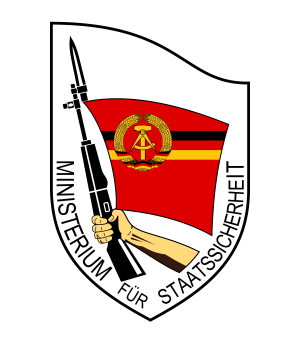Surveillance States were long used to repress citizens by State Actors. An examination of the Stasi will illustrate for us the parallels we are now seeing in the words and deeds of our government, Big tech and other corporations in America. But first…a historic overview of the Stasi.
Stasi was the colloquial name for the East German Secret Police. More formally, the, “Ministerium für Staatssicherheit, “(MfS) Ministry for State Security. Additionally, Stasi was referred to as, “Staatssicherheitsdienst,” (SSD) or, State Security Service. The Stasi was the internal Security arm of the German Democratic Republic (GDR). This was the East German Secret Police that operated from 1951 until 1989 until the fall of the Berlin Wall.

The MfS motto effectively conveyed their mission: “Shield and sword of the Party.” (Schild und Schwert der Partei)Party, referring to the “Sozialistische Einheitspartei Deutschlands, (SED) or, the, “East German Communist Party,” formed in April of 1946 with the merger of the Communist Party and the Social Democratic Party of Germany.
The SED was the single dominant party for the German Democratic Republic. A Marxist-Leninist political party that remained in power from its formation post World War II and remaining in power until its dissolution in 1989.
Zersetzung: “Decomposition,” of citizens of the State.

The Stasi was one of the most effective and repressive intelligence and secret police agencies ever to have existed. Erich Mielke was Mfs Chief of State Security from 1957 until November of 1989. Mielke set the agenda of identifying the political dissidents of the regime. MfS subsequently engaged in a campaign of,”Zersetzung,” meaning decomposition.
Zersetzung consisted of both covert and overt psychological destruction of alleged dissidents. Zersetzung implemented the disruption of the target dissident’s life both private and career. Stasi agents undertook psychological warfare on citizens, by breaking into homes and rearranging furniture and personal items. Agents might rearrange the time of an alarm clock; Stasi would remove Pictures from walls or, replacing a variety of tea with another. Stasi methods also employed personal property damage, sabotage of autos and bicycles, arranging for an incorrect or insufficient medical treatment or diagnosis. In a more serious act, The Stasi occasionally forced adoptions of the surveillance target’s children.
Disinformation: Lies, Smear campaigns and informers
Smear campaigns were common by Stasi operations. Common acts such as anonymously mailing photos that were falsified and compromising to the target’s family members. The Target’s family also could receive falsified documents of egregious or criminal claims. We see something similar to this taking place now in China with their Social Credit System.
The Stasi did simple and innovative things such as mysterious phone calls or deliveries of products not ordered. One such operation had a vibrator sent to the target’s wife. These tactics of oppression were so sophisticated; many thought that they were losing their minds. Frequently, mental breakdowns and suicides resulted.
The Oppressive Surveillance State

The MfS infiltrated nearly every aspect of people’s lives. The MfS arrested over 250,000 political prisoners during the tenure of its existence. By the mid 1980’s a sizeable network of informal collaborators grew in both German states. At the time of the fall of the Berlin Wall, Stasi employed over 91,000 employees and 173,000 informants. One in sixty-three East Germans were Stasi collaborators. When factored for informal collaborators and informants, the Stasi had one agent for every six people.
The Stasi took citizen surveillance to unprecedented, intrusive levels to gather deep knowledge about what people did and said which they used to manipulate and control the population.
Simon Wiesenthal once even stated, “The Stasi is even more oppressive than the Geheime StaatsPolizei” (Gestapo).
Making Citizens Disappear

From 1960 to 1981, Leipzig was the location where Death Sentences for the GDR took place. Before, in Dresden, The Condemned were executed by guillotine until 1968. From 1968-1980, a single gunshot to the back of the head became the preferred method at a jail, located at 47 Alfred Kästner-Straße, a residential area of a Leipzig suburb. The Stasi conducted their executions in total secrecy.
Political History is an important teacher, given the current political climate in America. I will be digging into the story of the Stasi to illustrate the political parallels we now face in America.
When the emotional and unhinged left talks about, Truth and Reconciliation Commissions, and “Re-Education of Trump Supporters,” understand where that comes from…Mostly, understand where it goes if left unchecked. We will dig into this with later entries.
